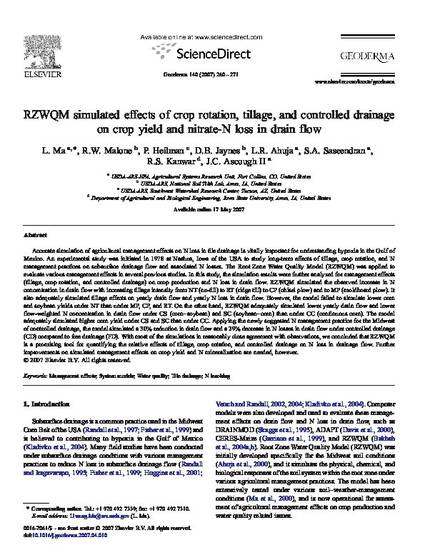
Accurate simulation of agricultural management effects on N loss in tile drainage is vitally important for understanding hypoxia in the Gulf of Mexico. An experimental study was initiated in 1978 at Nashua, Iowa of the USA to study long-term effects of tillage, crop rotation, and N management practices on subsurface drainage flow and associated N losses. The Root Zone Water Quality Model (RZWQM) was applied to evaluate various management effects in several previous studies. In this study, the simulation results were further analyzed for management effects (tillage, crop rotation, and controlled drainage) on crop production and N loss in drain flow. RZWQM simulated the observed increase in N concentration in drain flow with increasing tillage intensity from NT (no-till) to RT (ridge till) to CP (chisel plow) and to MP (moldboard plow). It also adequately simulated tillage effects on yearly drain flow and yearly N loss in drain flow. However, the model failed to simulate lower corn and soybean yields under NT than under MP, CP, and RT. On the other hand, RZWQM adequately simulated lower yearly drain flow and lower flow-weighted N concentration in drain flow under CS (corn–soybean) and SC (soybean–corn) than under CC (continuous corn). The model adequately simulated higher corn yield under CS and SC than under CC. Applying the newly suggested N management practice for the Midwest of controlled drainage, the model simulated a 30% reduction in drain flow and a 29% decrease in N losses in drain flow under controlled drainage (CD) compared to free drainage (FD). With most of the simulations in reasonably close agreement with observations, we concluded that RZWQM is a promising tool for quantifying the relative effects of tillage, crop rotation, and controlled drainage on N loss in drainage flow. Further improvements on simulated management effects on crop yield and N mineralization are needed, however.
Available at: http://works.bepress.com/rskanwar/43/

This article is from Geoderma 140 (2007): 260–271, doi:10.1016/j.geoderma.2007.04.010.